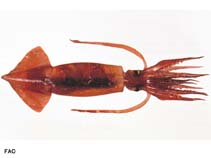Advertisement
Illex argentinus (Castellanos, 1960)
Argentine shortfin squid| Native range | All suitable habitat | Point map | Year 2050 |

|
| This map was computer-generated and has not yet been reviewed. |
| Illex argentinus AquaMaps Data sources: GBIF OBIS |
country information
Common names:
[No common name]
Occurrence:
Salinity:
Abundance: | Ref:
Importance: | Ref:
Aquaculture: | Ref:
Regulations: | Ref:
Uses: no uses
Comments:
National Checklist:
Country Information:
National Fisheries Authority:
Occurrences: Occurrences Point map
National Database:
Occurrence:
Salinity:
Abundance: | Ref:
Importance: | Ref:
Aquaculture: | Ref:
Regulations: | Ref:
Uses: no uses
Comments:
National Checklist:
Country Information:
National Fisheries Authority:
Occurrences: Occurrences Point map
National Database:
Common names from other countries
Classification / Names Common names | Synonyms | Catalog of Fishes (gen., sp.) | ITIS | CoL | WoRMS
Environment: milieu / climate zone / depth range / distribution range Ecology
Pelagic; depth range 0 - 800 m (Ref. 275), usually 50 - 200 m (Ref. 275). Subtropical, preferred 10°C (Ref. 107945); 20°S - 50°S, 68°W - 46°W (Ref. 275)
Distribution Countries | FAO areas | Ecosystems | Occurrences | Introductions
Southwest Atlantic, Southeast Pacific and Antarctic Indian Ocean. Subtropical to polar.
Length at first maturity / Size / Weight / Age
Maturity: Lm ?, range 24 - ? cm Max length : 40.0 cm ML male/unsexed; (Ref. 105659)
Life cycle and mating behavior Maturity | Reproduction | Spawning | Eggs | Fecundity | Larvae
Members of the class Cephalopoda are gonochoric. Male and female adults usually die shortly after spawning and brooding, respectively. Mating behavior: Males perform various displays to attract potential females for copulation. During copulation, male grasp the female and inserts the hectocotylus into the female's mantle cavity where fertilization usually occurs. Life cycle: Embryos hatch into planktonic stage and live for some time before they grow larger and take up a benthic existence as adults.
Main reference
References | Coordinator | Collaborators
Roper, C.F.E., M.J. Sweeney and C.E. Nauen. 1984. (Ref. 275)
IUCN Red List Status
(Ref. 130435: Version 2024-2)
Least Concern (LC) ; Date assessed: 05 May 2010
CITES status (Ref. 108899)
Not Evaluated
CMS (Ref. 116361)
Not Evaluated
Human uses
Fisheries: commercial
FAO - Fisheries: landings, species profile | FishSource | Sea Around Us
Tools
More information
Internet sources
BHL | BOLD Systems | CISTI | DiscoverLife | FAO(Fisheries: species profile; publication : search) | GenBank (genome, nucleotide) | GloBI | Gomexsi | Google Books | Google Scholar | Google | PubMed | Tree of Life | Wikipedia (Go, Search) | Zoological Record
Estimates based on models
Preferred temperature
(Ref. 115969): 4.4 - 12.1, mean 7.3 (based on 234 cells).
Resilience
(Ref. 69278)
High, minimum population doubling time less than 15 months (K=0.93-0.96).
Prior r = 1.00, 95% CL = 0.66 - 1.49, Based on 1 data-limited stock assessment.




